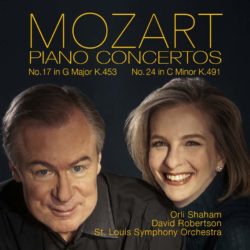Classical Music CD Reviews: Two Refreshingly Different Takes On Mozart
By Susan Miron
Two recordings serve up the music of Mozart in unusual packages.

The Jupiter Project: Mozart in the nineteenth-century drawing room (Hyperion) is a fascinating CD, an aural excursion into what the music of Mozart must have sounded like to middle-class people in Britain in the years after his death (1791) to about 1850. Of course, many of his works in a number of countries were arranged for one piano or piano four-hands. But there was a tradition, in England, of creating arrangements of his symphonies, concerti, and overtures for a quartet of piano, flute, violin, and cello.
These reconfigurations and arrangements were published in London, where the piano/violin/flute/cello ensemble was all the rage, popularizing Haydn & Beethoven symphonies and overtures from Auber to Weber. Selections from oratorios and opera were made available — even the Mendelssohn Octet. These pocket-size versions for piano, flute, violin, and cello were presented in professional performances and in upper-class homes, often played by musical amateurs. This CD features an exuberant Overture to The Magic Flute, K. 620; the popular C-major Piano Concerto No. 21, K 467; Overture to The Marriage of Figaro, K. 492, and Symphony No. 41, Jupiter, K. 551. The flute was in vogue during this period, and it played the oboe parts as well. The violin and cello took all the string parts; the piano took charge of the horn and brass parts.
The performances of these shrunken orchestrations are admirable throughout. David Owen Norris plays the solo piano part in the concerto, as well as the lion’s share of notes in the other selections, deftly. Understandably, all four of these works proffer a different energy and soundscape than the versions we are accustomed to in the 21st century. But so what? They are seriously entertaining even if drastically reduced in forces — ebullient and, at times, quite moving.
The mastermind behind The Jupiter Project is Norris, who shared the musical detective work with Mark Everest. The three other players on the recording are excellent: Katy Bircher, flute; Caroline Balding, violin; and Andrew Skidmore, cello. Muzio Clementi, Johann Nepomuk Hummel, and Jean Baptist Cramer are the composers/virtuoso pianists drawn on in these, at first, exotic sounding arrangements. It took me several hearings, but I quite unexpectedly started to like these refashioned pieces in forms I hadn’t previously imagined.
 Pianist Orli Shaham, whom I admired on Avner Dorman’s CD Letters from Gettysburg, delivers two ravishing, full-blooded Mozart concerti in a recording that I have come to love. Mozart Piano Concertos Nos. 17 in G Major, K. 453, and No. 24 in C Minor, K. 491 (Canary Classics) is a real beauty, from the performance of the superb St. Louis Symphony Orchestra, conducted by David Robertson (Shaham’s husband), to the clarity and musical responsiveness of the piano, which makes Mozart’s famed concerti sound like chamber music. Shaham’s cadenzas are elegant, her passage work shimmering, her sound and playing simply ravishing.
Pianist Orli Shaham, whom I admired on Avner Dorman’s CD Letters from Gettysburg, delivers two ravishing, full-blooded Mozart concerti in a recording that I have come to love. Mozart Piano Concertos Nos. 17 in G Major, K. 453, and No. 24 in C Minor, K. 491 (Canary Classics) is a real beauty, from the performance of the superb St. Louis Symphony Orchestra, conducted by David Robertson (Shaham’s husband), to the clarity and musical responsiveness of the piano, which makes Mozart’s famed concerti sound like chamber music. Shaham’s cadenzas are elegant, her passage work shimmering, her sound and playing simply ravishing.
The choice of making use of large orchestration and a modern piano were hers. Shaham explains that “the traditional playing styles and instruments revived by historically informed performance are only one type of strategy for revealing what makes the music special.” In the CD’s fascinating notes, a conversation about Mozart among Shaham, Robertson, and historian Elaine Sisman, Shaham argues that “these two concerti are the only two Mozart wrote whose last movements consist of strict variations on a single theme… Mozart is showing his skill in two ways: he’s pushing the envelope of how much a composer can get out of a single idea, but also the envelope of what pianists could do technically … ”
Shaham has parallel careers as a respected broadcaster, music lecturer, and writer, along with being the frequent piano collaborator of her brother, violinist Gil Shaham. On this CD she performs Mozart, and talks about composer with educative aplomb: “In these concertos, Mozart wants to get from a musical point A to a musical point B, and variation is his ticket to ride…. For Mozart, changes (or variations) aren’t just a means to a musical end. He starts with a musical theme and, through a progressive series of fairly small changes, moves it into something that feels quite new…. It’s hard to find moments in these concertos in which a phrase repeats exactly as it was. We can think of this as a play-by-play view of what’s happening in Mozart’s musical brain, trying out different ideas and versions, punning and free-associating melodically.”
Susan Miron, a harpist, has been a book reviewer for over 30 years for a large variety of literary publications and newspapers. Her fields of expertise were East and Central European, Irish, and Israeli literature. Susan covers classical music for The Arts Fuse and The Boston Musical Intelligencer.
Tagged: Canary Classics, David Robertson, Hyperion Records, Orli Shaham, St. Louis Symphony Orchestra
